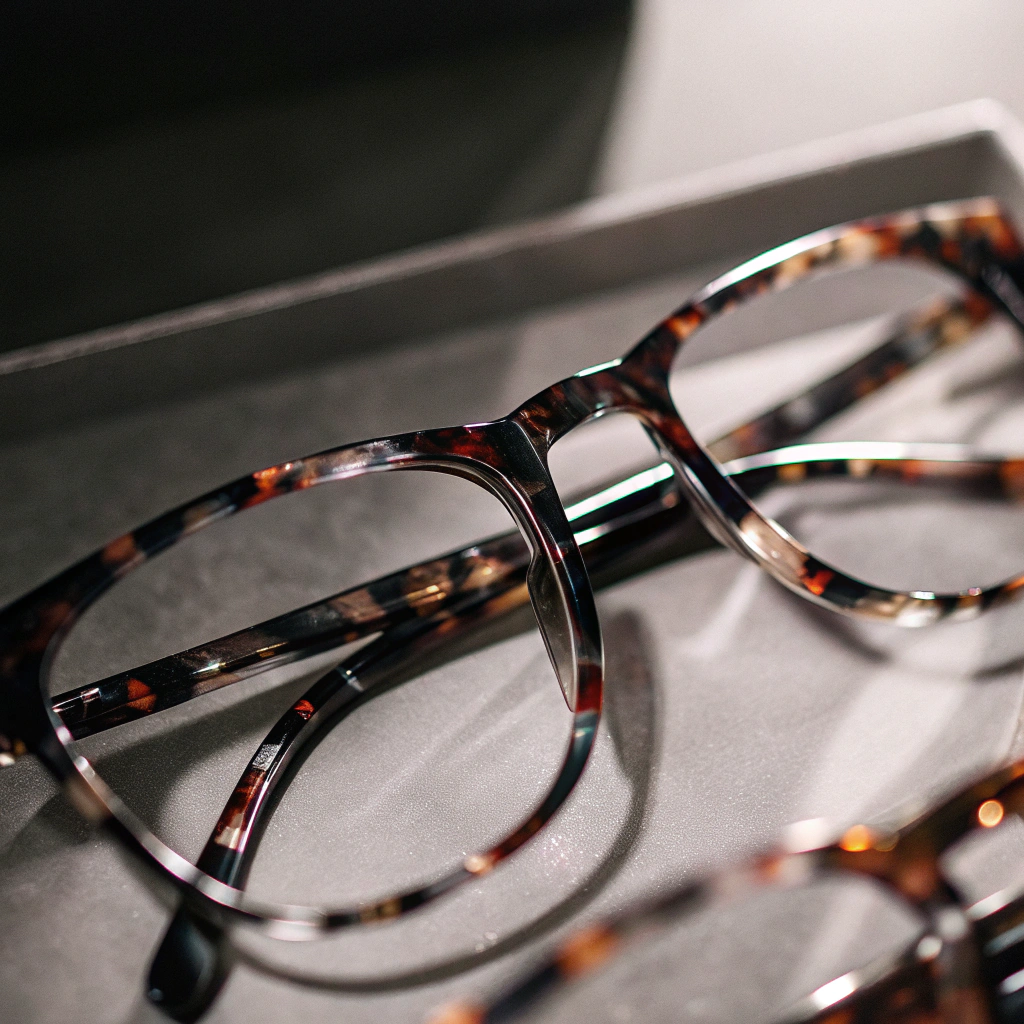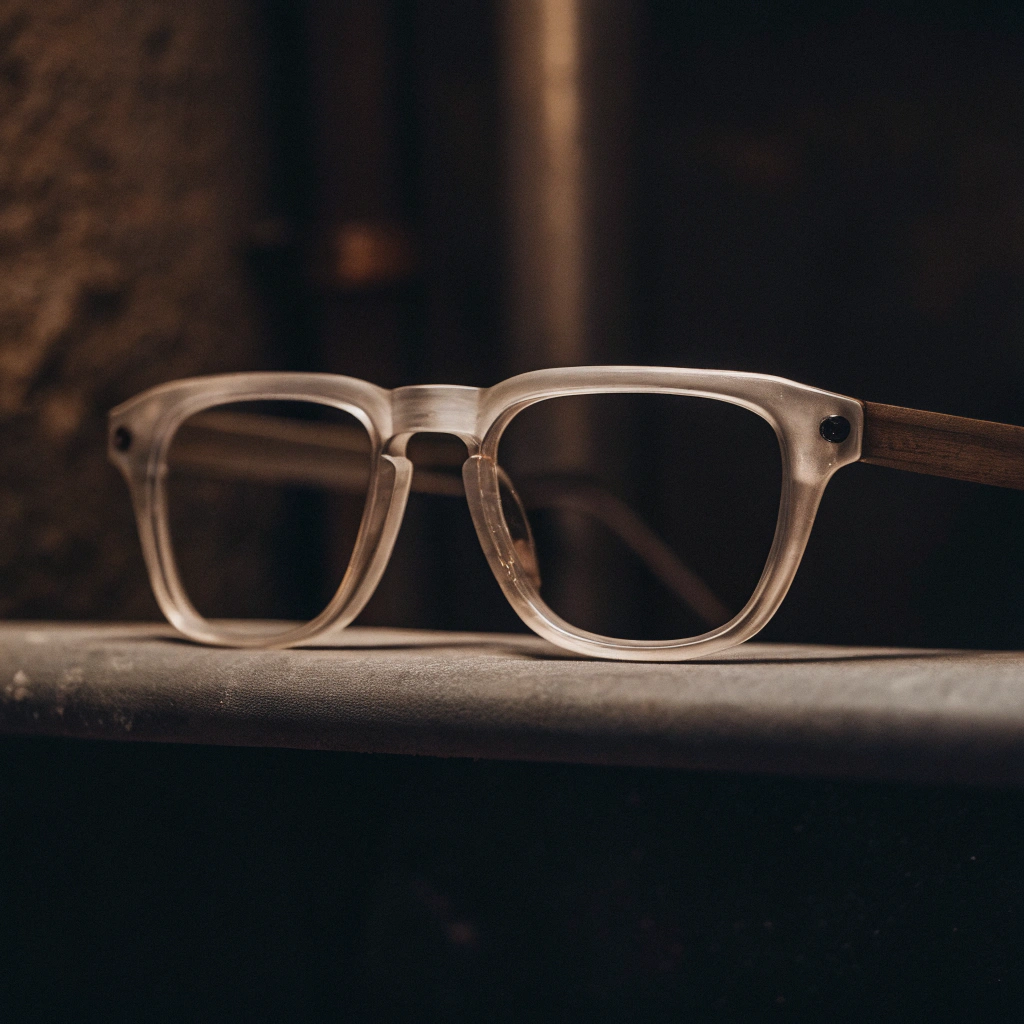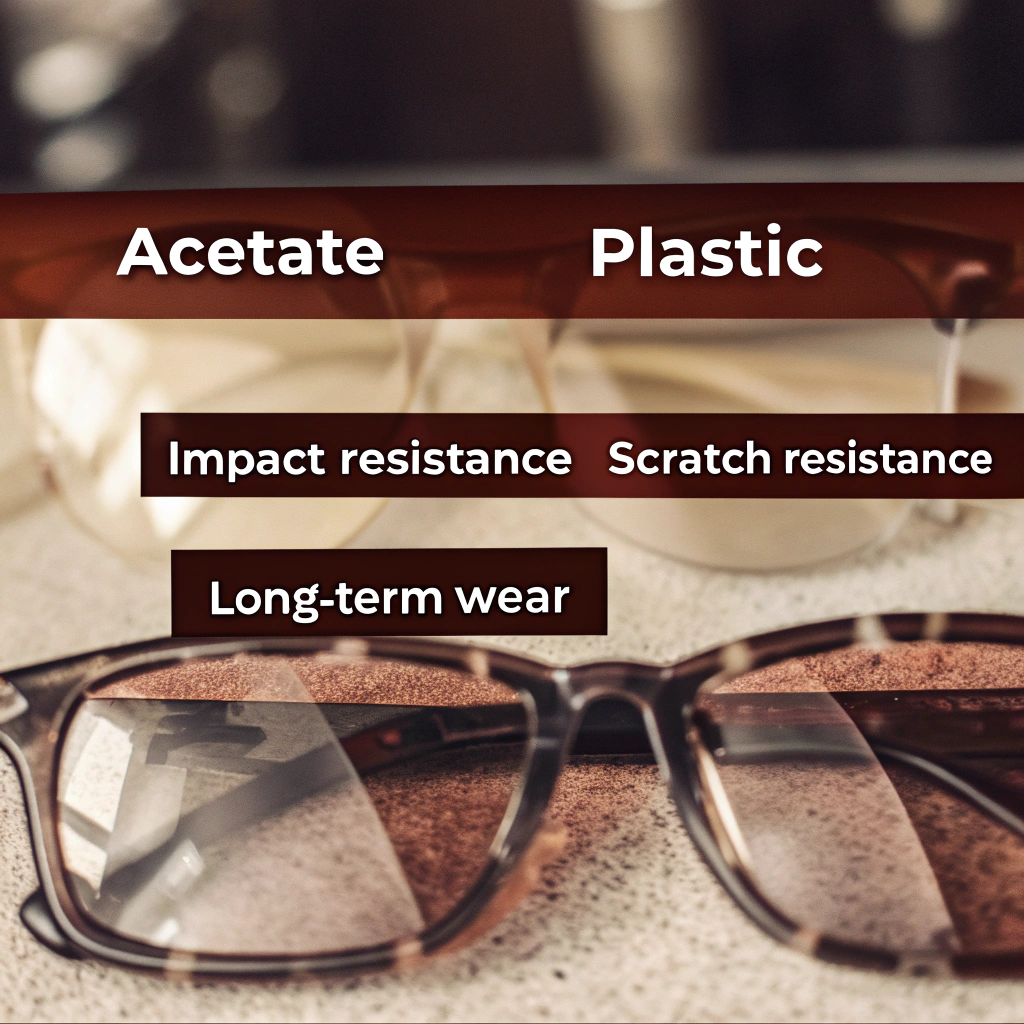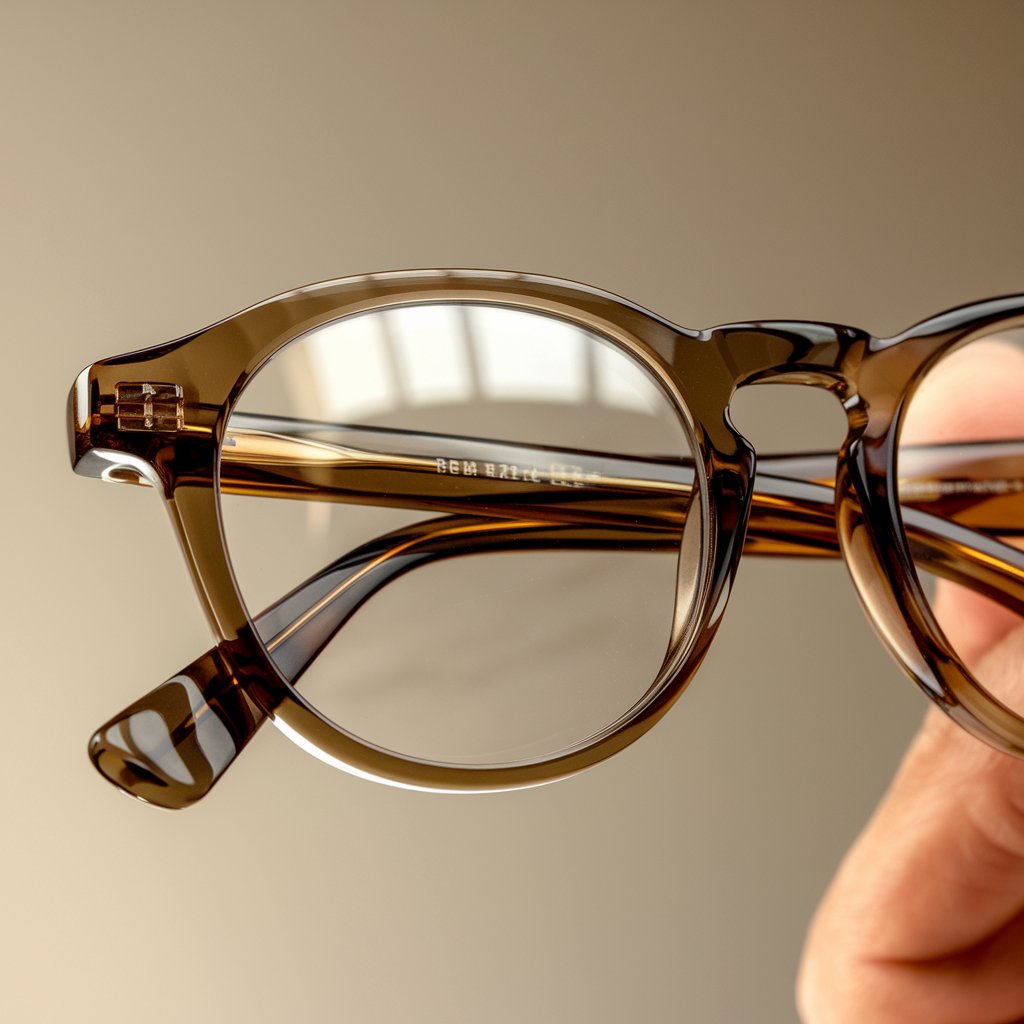When it comes to choosing the right eyewear material, many people struggle to decide between acetate and plastic glasses. Both materials have their unique advantages and drawbacks, and understanding the key differences can help you make an informed choice for your eyewear needs. So, what’s the real story? In this article, we will explore the differences between acetate and plastic glasses, their manufacturing processes, comfort, durability, environmental impact, and much more. Let’s dive into the details!
1. What Are Acetate Glasses?
Acetate glasses are a popular choice in the eyewear industry, known for their high-quality finish and ability to be molded into a variety of styles. Acetate is a plant-based material derived from cotton and wood pulp, making it more eco-friendly compared to many synthetic materials. But here’s the kicker: acetate offers exceptional durability and can be shaped into complex designs, which is why it’s favored by many high-end eyewear brands.

Acetate glasses also tend to have a smoother and more luxurious feel. Their lightweight nature makes them comfortable for long-term wear, and they come in a variety of colors and patterns that are hard to achieve with plastic. In addition, acetate is hypoallergenic, making it a great choice for those with sensitive skin. So, if you’re looking for a material that combines style, comfort, and eco-friendliness, acetate glasses might just be your best option.
One of the significant benefits of acetate glasses is their ability to be customized. Eyewear manufacturers can blend various colors into the material, creating unique designs that stand out. This gives you a wide range of options, from subtle, muted tones to bold and vibrant colors. But, just because acetate is more flexible and fashionable doesn’t mean it’s immune to wear and tear. Over time, acetate can become more prone to cracking, especially in extreme temperature changes.
Acetate Glasses vs. Plastic Glasses Table
| Feature | Acetate Glasses | Plastic Glasses |
|---|---|---|
| Material | Plant-based (cotton, wood pulp) | Synthetic polymers |
| Durability | High, but can crack in extreme conditions | Moderate, more prone to scratches |
| Customization | High, can blend colors easily | Limited color options |
| Comfort | Lightweight, smooth finish | Heavier, can feel stiff |
2. What Are Plastic Glasses?
Plastic glasses, also known as injection-molded frames, are made from synthetic polymers. These materials are often derived from petroleum, making plastic less eco-friendly than acetate. However, plastic glasses are highly durable and resistant to impact, which is why they are a popular choice for everyday eyewear. What’s the real story with plastic glasses? Well, while they may not be as luxurious as acetate, they offer several practical benefits.

Plastic glasses are typically more affordable than acetate frames, making them an excellent choice for budget-conscious buyers. Additionally, they are lightweight and flexible, which helps prevent them from becoming uncomfortable during extended wear. However, plastic frames can become brittle over time, especially if exposed to UV rays or high heat. This is a significant drawback if you need glasses that will withstand years of use.
Despite these drawbacks, plastic glasses come in a wide variety of designs and colors. Manufacturers can mold plastic into virtually any shape, offering flexibility in terms of both style and functionality. This makes plastic a versatile material that suits a wide range of eyewear preferences. However, one downside is that plastic frames often lack the luxurious feel and customizability of acetate.
Plastic Glasses vs. Acetate Glasses Table
| Feature | Plastic Glasses | Acetate Glasses |
|---|---|---|
| Material | Synthetic polymers | Plant-based (cotton, wood pulp) |
| Durability | Moderate, resistant to impact | High, but cracks in extreme conditions |
| Customization | Limited color options | High, can blend colors easily |
| Comfort | Lightweight, but can feel stiff | Lightweight, smooth finish |
3. How Are Acetate and Plastic Glasses Made?
The manufacturing process for acetate and plastic glasses differs significantly, which affects both the quality and style of the finished product. Ready for the good part? Let’s break it down!
Acetate glasses are made by combining cotton fibers and wood pulp, which are processed to form a plastic sheet. The sheet is then heated and molded into the desired shape. This process allows for intricate designs and color variations. One of the key advantages of acetate is that the material can be polished to a glossy finish, giving it a premium look and feel.
On the other hand, plastic glasses are made using a process known as injection molding. Plastic pellets are melted and injected into molds, where they cool and solidify. This method is faster and more cost-effective than the acetate molding process, making it a more popular choice for mass production. However, injection-molded plastic frames are generally more uniform in appearance and lack the rich color options and detailing that acetate can provide.
Acetate vs. Plastic Glasses Manufacturing Table
| Process | Acetate Glasses | Plastic Glasses |
|---|---|---|
| Material | Cotton fibers, wood pulp | Synthetic polymer pellets |
| Production Method | Heated and molded | Injection molded |
| Cost | Higher, more labor-intensive | Lower, mass production |
| Design Flexibility | High, intricate designs | Moderate, less detailed |
4. What Are the Differences in Durability Between Acetate and Plastic Glasses?
Durability is one of the key factors when deciding between acetate and plastic glasses. So, how do they stack up? Acetate glasses are generally more durable than plastic glasses. This is due to the material’s inherent resistance to wear and tear, and the fact that it tends to hold its shape better over time.
However, acetate can be more vulnerable to cracking under extreme conditions. For instance, if exposed to sudden temperature changes or excessive force, acetate frames may crack or break. Plastic glasses, on the other hand, are more likely to warp or lose their shape with prolonged exposure to heat. But here’s the kicker: plastic frames are often more resistant to daily wear and tear, such as scratches.
Ultimately, both materials have their pros and cons when it comes to durability. If you’re looking for long-term durability with a premium look, acetate might be the better choice. But if you want something that can handle rough treatment and still look good, plastic glasses might be more suitable.

Durability Comparison Table
| Feature | Acetate Glasses | Plastic Glasses |
|---|---|---|
| Resistance to Scratches | Moderate | High |
| Resistance to Cracking | High, but cracks in extreme conditions | Low, more likely to warp |
| Impact Resistance | Moderate | High |
5. How Do Acetate and Plastic Glasses Compare in Terms of Comfort?
Comfort is essential when choosing eyewear, and both acetate and plastic glasses offer unique benefits in this regard. But here’s where it gets interesting: acetate frames are typically lighter and more comfortable for long-term wear. The smooth finish of acetate makes it less likely to irritate the skin, especially around the nose and ears. Many people find acetate glasses more comfortable for extended wear because of this soft, smooth feel.
Plastic glasses, while lightweight, can sometimes feel stiffer and less comfortable, especially if the frame isn’t well-designed. In addition, plastic frames can be more prone to causing discomfort over time, especially if they become brittle. However, advancements in plastic eyewear manufacturing have improved the comfort of plastic frames, with many now featuring padded nose pieces and flexible temples.
Comfort Comparison Table
| Feature | Acetate Glasses | Plastic Glasses |
|---|---|---|
| Weight | Lightweight, comfortable | Lightweight, but stiffer |
| Skin Irritation | Low, smooth finish | Moderate, can irritate |
| Fit | Flexible, custom fit | Can feel rigid |
6. Are Acetate Glasses More Stylish Than Plastic Glasses?
When it comes to style, acetate glasses have the upper hand. Acetate frames are known for their premium feel and ability to incorporate unique, vibrant color patterns. Many high-end eyewear brands use acetate to create bold, eye-catching designs. What’s the real story with acetate’s style? Acetate glasses can be made in an array of rich, sophisticated colors, often with a translucent finish that adds depth and character to the design.
On the other hand, plastic glasses tend to be more uniform in appearance. While they are available in various colors, plastic frames lack the same level of customization and detailing that acetate frames offer. This doesn’t mean plastic glasses are unattractive; they come in a variety of shapes and colors, but they often don’t have the same level of craftsmanship as acetate glasses.
Style Comparison Table
| Feature | Acetate Glasses | Plastic Glasses |
|---|---|---|
| Customization | High, intricate designs | Moderate, basic colors |
| Aesthetic Appeal | Premium, unique patterns | Uniform, basic designs |
| Flexibility | High, can create bold shapes | Low, more limited shapes |
7. How Do Acetate and Plastic Glasses Perform in Terms of Flexibility?
When it comes to flexibility, acetate glasses generally outperform plastic glasses. Acetate is a more pliable material, meaning it can be adjusted to better fit the wearer’s face. This is why many custom eyewear makers prefer acetate for creating personalized frames. What’s the catch? While acetate is more flexible than plastic, it still has its limits. Acetate frames can break if over-adjusted or bent too many times.
Plastic glasses are typically stiffer and may not offer the same level of comfort or fit. However, newer plastic materials have been developed to increase flexibility, and some high-quality plastic frames now feature adjustable nose pads and temples that improve the fit. While plastic frames may not be as flexible as acetate, they can still be molded to provide a comfortable fit for many people.
Flexibility Comparison Table
| Feature | Acetate Glasses | Plastic Glasses |
|---|---|---|
| Adjustability | High, can be shaped easily | Low, limited adjustment |
| Flexibility | Moderate, but can crack | Low, stiff but flexible models available |
| Comfort Fit | Customizable fit | Basic fit, but adjustable features |
8. Are Acetate or Plastic Glasses More Eco-Friendly?
When considering the environmental impact of eyewear, acetate glasses tend to be more eco-friendly than plastic glasses. Acetate is made from plant-based materials, primarily cotton and wood pulp, which makes it biodegradable and more sustainable in comparison to plastic. What’s the real story here? Acetate glasses are a more environmentally friendly option because they are derived from renewable resources. They are also easier to break down when they are disposed of, reducing long-term waste.
In contrast, plastic glasses are typically made from petroleum-based materials, which are non-renewable and less environmentally friendly. Plastic glasses are not biodegradable and contribute to plastic pollution, which is a significant environmental concern. However, some manufacturers are working on creating more eco-friendly plastic alternatives, like recycled plastics or bioplastics, but they are still not as sustainable as acetate.
That said, when considering eco-friendly eyewear, it’s important to also look at factors such as how glasses are disposed of, as well as the sustainability practices of the eyewear brand itself. For instance, some eyewear companies offer recycling programs, which can reduce the overall environmental impact of their products.
Eco-Friendliness Comparison Table
| Feature | Acetate Glasses | Plastic Glasses |
|---|---|---|
| Material | Plant-based (cotton, wood pulp) | Petroleum-based |
| Biodegradability | Biodegradable | Non-biodegradable |
| Sustainability | High, renewable resources | Low, non-renewable resources |
| Environmental Impact | Lower, less pollution | Higher, contributes to plastic waste |
9. How Do Acetate and Plastic Glasses Compare in Terms of Price?
Price is always a key consideration when making a purchase, especially in the B2B eyewear market. When comparing acetate and plastic glasses, acetate tends to be more expensive. This is largely due to the higher cost of raw materials, as well as the more intricate manufacturing process involved in creating acetate eyewear. What’s the kicker with acetate prices? Acetate glasses are often seen as a premium product, offering a luxurious feel and superior customization options. As a result, they come with a higher price tag.
On the other hand, plastic glasses are generally more affordable due to their mass production and lower manufacturing costs. This makes them a popular choice for businesses looking to offer cost-effective eyewear solutions to their customers. However, it’s important to note that while plastic glasses are cheaper, they may not offer the same level of durability, customization, or style that acetate glasses provide.
So, what’s the best choice for your business? If you’re working with a budget and need affordable eyewear options, plastic glasses may be the way to go. But if you’re looking for high-end products that offer style, comfort, and long-term durability, then acetate glasses are worth the investment.
Price Comparison Table
| Feature | Acetate Glasses | Plastic Glasses |
|---|---|---|
| Cost | Higher, premium quality | Lower, cost-effective |
| Customization | High, intricate designs | Limited options |
| Durability | High, premium materials | Moderate, less durable |
| Target Market | High-end, fashion-focused | Budget-conscious consumers |
10. Which Type of Glasses is Better for Prescription Lenses?
When it comes to prescription lenses, both acetate and plastic glasses can accommodate corrective lenses. However, acetate glasses tend to provide a better fit for custom prescription lenses. Why? Acetate frames can be more easily adjusted, allowing for a perfect fit and better comfort for those who wear prescription eyewear. Additionally, the smooth, flexible nature of acetate allows the lenses to sit securely in the frame, reducing the chances of them shifting or falling out over time.
Plastic glasses, while they can certainly hold prescription lenses, may not offer the same level of customization. Due to the stiffer nature of plastic, the fit can sometimes be less secure, and certain frame styles may not be ideal for custom lenses. But here’s the thing: plastic eyewear is still a great option for people who need basic prescription lenses at a lower cost.
If your business specializes in prescription eyewear, it’s essential to consider the material that best suits your customers’ needs. For higher-end, customized eyewear, acetate is the preferred option. But for more budget-friendly prescriptions, plastic glasses could still serve your customers well.

Prescription Lens Compatibility Table
| Feature | Acetate Glasses | Plastic Glasses |
|---|---|---|
| Fit for Prescription Lenses | High, customizable | Moderate, less flexible |
| Comfort | Flexible, comfortable | Stiff, may need adjustments |
| Suitability | Best for high-end prescriptions | Good for budget prescriptions |
11. How Do Acetate and Plastic Glasses Compare in Terms of Maintenance?
When it comes to maintenance, acetate glasses generally require more care than plastic glasses. Acetate is a high-quality material that can be easily scratched, so regular cleaning and proper storage are essential to maintaining its appearance. What’s the real story with acetate maintenance? Acetate glasses should be cleaned with a soft cloth and a mild cleaning solution to avoid scratching the surface. They should also be stored in a case when not in use to prevent damage from being dropped or exposed to rough surfaces.
Plastic glasses are generally easier to maintain because they are more resistant to scratches and other forms of damage. However, plastic frames can still get dirty or stained, and it’s essential to clean them regularly to maintain their appearance. What’s the kicker with plastic glasses? They may not require as much upkeep as acetate, but they are more likely to show signs of wear and tear over time.
In terms of overall maintenance, both materials are fairly easy to care for, but acetate glasses do require a bit more attention to keep them looking their best.
Maintenance Comparison Table
| Feature | Acetate Glasses | Plastic Glasses |
|---|---|---|
| Cleaning | Regular cleaning required | Easy to clean, low maintenance |
| Scratching | Moderate, requires protection | Low, resistant to scratches |
| Storage | Must be stored properly | Less critical, more durable |
12. Are There Any Health Benefits to Choosing Acetate Over Plastic?
When choosing eyewear, health considerations are essential, especially when it comes to materials that come into direct contact with the skin. Acetate glasses are hypoallergenic, making them a great choice for people with sensitive skin or allergies. What’s the real story here? Acetate’s plant-based origin means it’s less likely to cause skin irritation or allergic reactions compared to plastic, which is made from synthetic materials that can sometimes trigger sensitivities.
Plastic glasses, while generally safe, are more likely to cause discomfort or irritation over time, especially if they are not made with hypoallergenic materials. However, many modern plastic frames now come with hypoallergenic nose pads and other features to improve comfort and reduce irritation.
If health and comfort are important to your customers, acetate glasses might be the better choice. Not only do they offer a premium look and feel, but they are also more likely to be gentle on sensitive skin.
Health Considerations Table
| Feature | Acetate Glasses | Plastic Glasses |
|---|---|---|
| Hypoallergenic | Yes, plant-based material | No, may cause irritation |
| Skin Comfort | High, soft finish | Moderate, may cause discomfort |
| Health Benefits | Reduces skin irritation | Can cause irritation without proper care |
13. Which Material Is Better for Sports or Active Lifestyles?
When it comes to active use, plastic glasses tend to perform better than acetate. Why? Plastic is more durable and resistant to impact, making it a great option for sports or outdoor activities. Plastic frames are less likely to break if dropped or bent, and they can handle the wear and tear that comes with active use. But here’s the kicker: while plastic is more durable, it may not offer the same level of comfort and style as acetate.
Acetate glasses, on the other hand, are more likely to crack or break under intense physical activity. However, if you’re looking for eyewear that balances style with comfort, acetate is still a solid option for less demanding physical activities.
Ultimately, the material you choose depends on the specific needs of your customers. If your target market is active and needs eyewear that can withstand rough treatment, plastic glasses are the better option. But if you’re catering to customers who want a balance of style and comfort, acetate may still be a viable choice.
Sports Use Comparison Table
| Feature | Acetate Glasses | Plastic Glasses |
|---|---|---|
| Durability | Moderate, can crack | High, impact-resistant |
| Comfort | High, flexible | Moderate, less flexible |
| Ideal Use | Casual, less physical | Active, sports, outdoor use |
14. Can Acetate and Plastic Glasses Be Customized?
Customization is one of the most important factors for eyewear brands, and both acetate and plastic glasses can be customized to meet specific needs. However, acetate stands out in this area because of its versatility. Acetate glasses can be easily molded and colored in a variety of ways, which allows eyewear manufacturers to create unique and intricate designs. What’s the kicker with acetate customization? The material allows for a wider range of colors and patterns, giving you the ability to create eyewear that reflects your brand’s identity.
Plastic glasses can also be customized, but their design options are more limited. The manufacturing process for plastic eyewear is less flexible, so the customization tends to be more basic compared to acetate. However, advances in plastic eyewear production have allowed for more customization options, including printing logos or adding unique details to the frames.
For eyewear businesses looking for bespoke designs, acetate is likely the better option. But if you’re working with a tight budget or need mass production, plastic eyewear may still offer the flexibility needed to serve your customers’ needs.
Customization Comparison Table
| Feature | Acetate Glasses | Plastic Glasses |
|---|---|---|
| Customization Options | High, intricate designs | Moderate, basic designs |
| Manufacturing Flexibility | Very flexible, detailed | Limited flexibility |
| Branding Potential | High, ideal for unique designs | Low, mass production focus |
15. What Is the Lifespan of Acetate and Plastic Glasses?
The lifespan of your glasses depends heavily on the material and how well they are cared for. Acetate glasses tend to have a longer lifespan if maintained properly. Acetate is a strong and durable material, but it can be prone to cracking or chipping under certain conditions. However, with proper care, acetate glasses can last for several years.
Plastic glasses, while durable in the short term, generally have a shorter lifespan compared to acetate. They are more likely to show signs of wear, such as fading, scratches, or deformation, over time. However, plastic frames are often cheaper, which means businesses can afford to replace them more frequently without significant cost implications.
If longevity is a priority for your customers, acetate glasses are likely the better choice. However, for those on a tighter budget, plastic glasses may still offer a practical and affordable solution.
Lifespan Comparison Table
| Feature | Acetate Glasses | Plastic Glasses |
|---|---|---|
| Durability | High, with proper care | Moderate, can show wear |
| Lifespan | Long-lasting, 5-7 years | Shorter, 2-3 years |
| Cost | Higher, but long-lasting | Lower, but requires replacement sooner |
Conclusion
In conclusion, both acetate and plastic glasses have their advantages and limitations. Acetate glasses stand out for their luxurious feel, durability, and customization options, making them a top choice for fashion-conscious buyers. Plastic glasses, on the other hand, are more affordable, durable in certain aspects, and ideal for those who need a sturdy, no-frills option. Ultimately, the right choice depends on your specific needs, preferences, and budget. If you prioritize style, customization, and eco-friendliness, acetate glasses are the way to go. But if you’re looking for a cost-effective, resilient choice, plastic glasses could be the better option.
FAQ Section
Q1: What is the difference between acetate and plastic glasses?
Acetate glasses are made from plant-based materials, offering better durability and comfort, while plastic glasses are typically made from synthetic polymers and are more affordable but less durable.
Q2: How does acetate compare to plastic in terms of weight?
Acetate glasses are generally lighter and more comfortable, while plastic glasses tend to be slightly heavier.
Q3: Are acetate glasses more durable than plastic glasses?
Yes, acetate glasses are typically more durable and resistant to damage, while plastic glasses can be more prone to scratches and breaking.
Q4: Are acetate glasses eco-friendly?
Yes, acetate is biodegradable and made from renewable resources, making it more eco-friendly compared to plastic, which is petroleum-based and less sustainable.
Q5: Can acetate and plastic glasses be customized?
Both acetate and plastic glasses can be customized in terms of color, style, and prescription lenses, but acetate offers more flexibility in terms of unique designs and finishes.

